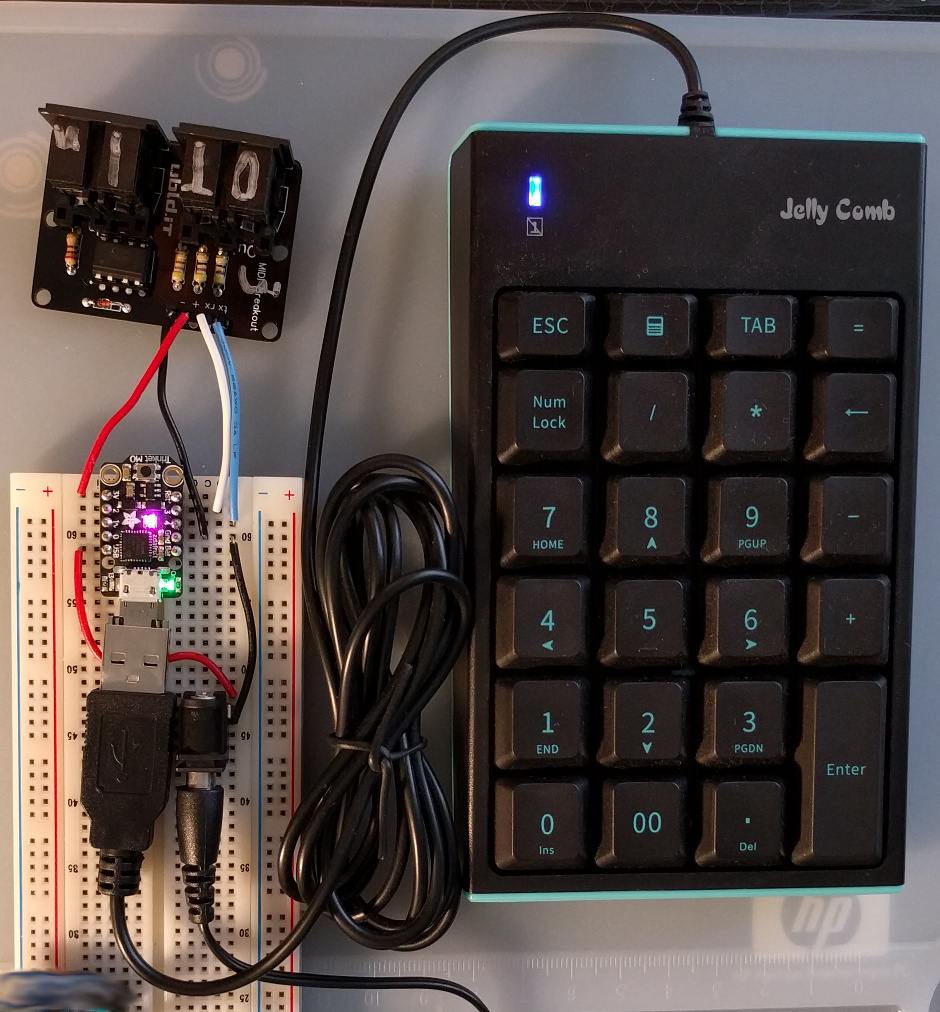The photo shows a numeric keypad but a 101 key keyboard can be used.
The USB keyboard is plugged into the Adafruit Trinket M0 (SAMD21) using a USB OTG to USB host adapter. The Trinket M0 sketch translates USB key codes to MIDI messages using the Arduino MIDI library. The MIDI messages are sent out the Serial1 hardware UART to a MIDI breakout board with MIDI DIN connectors.
The sketch demonstrates how to send MIDI messages such as Note On/Off, Program Change, and System Exclusive.
Since this project uses MIDI DIN connectors, it can be connected directly to a MIDI synth with DIN connectors. No computer required.
If you want to connect this project to a computer via USB, see the related project https://github.com/gdsports/MIDIUARTUSB. Remove the MIDI breadout board then connect the Trinket M0 Tx/Rx to the Pro Micro Rx/Tx. More on this later.
- Adafruit Trinket M0
NOTE: The Trinket M0 is very different from the original Trinket. This project does not work on the original Trinket.
Be sure to work through the Adafruit tutorial to install the board package and run at least one example program. This ensures the board is working before connecting the other parts.
https://www.adafruit.com/product/3500
- USB OTG to USB host cable or adapter
The photo shows the tiny adapter instead of the cable. One problem with the adapter is it is so small so it is easy to lose. And it looks like it broke off from another piece of gear!
These are generic parts so they can be purchased from many other stores.
https://www.adafruit.com/product/1099
https://www.adafruit.com/product/2910
- 5 V, 500 mA DC power supply and connector
The photo shows a barrel jack since it can be used on a bread board but any connector that matches the power supply can be used.
NOTE: Connect 5V to the Trinket M0 only when it is not connected to a computer. When connected to a computer the Trinket M0 receives power via its USB connector. The power supply must be connected when the Trinket M0 is connected to a USB keyboard since the Trinket M0 must supply power to the keyboard.
- MIDI breakout board
The MIDI board in the photo came as a kit for 5V logic levels so it has substituted resistors for 3.3V operation. The following PJRC guide for Teensy 3.x is useful because Teensy 3.x uses the same 3.3V logic levels as the Trinket M0.
https://www.pjrc.com/teensy/td_libs_MIDI.html
The USB host library is included with the Trinket M0 board package so it does not need to be installed.
Install the MIDI Library by Forty Seven Effects using the IDE library manager.
When using USB host mode, uploading new code requires double pressing the Trinket M0 reset button. Once USB host mode is used, the Trinket M0 no longer appears as a serial/COM port so the Arduino IDE thinks it is not connected. The solution is to force the Trinket M0 into upload mode by double pressing the reset button. Then start the upload via the IDE. This may take a few tries to get the timing right.
Doing it in the opposite order also works. Start the IDE upload then when the IDE saying "Uploading" press the Trinket M0 reset button.
| 5V DC | Trinket M0 | MIDI breakout |
|---|---|---|
| 3V | + | |
| 2 | ||
| 1~ | ||
| 0 | ||
| 5V | USB | |
| RST | ||
| 3 UART Rx | Rx | |
| 4 UART Tx | Tx | |
| GND | GND | - |
| BAT |
